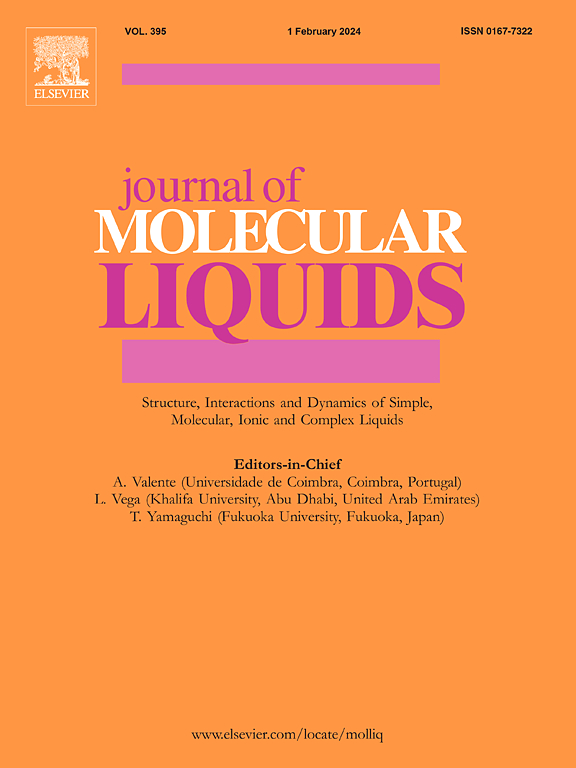Encapsulation of 3-acetylcoumarin with acyclic cucurbit[n]urils: characterization/improved water solubility and thermal stability/retain biological activity
IF 5.3
2区 化学
Q2 CHEMISTRY, PHYSICAL
引用次数: 0
Abstract
3-Acetylcoumarin (3-Ace), as a derivative of coumarin, retains the antibacterial, antioxidant, anticancer properties, and fluorescence imaging characteristics of coumarin very well. However, its low water solubility limits its applications. In this study, 3-Ace was encapsulated using two newly synthesized acyclic cucurbit[n]urils (ACBs), M1 and M2, to enhance its solubility and retain its biological efficacy. The successful formation of the inclusion complexes was confirmed through various techniques, including 1H NMR, 2D-ROESY NMR, fluorescence titration, 1H NMR titration, FT-IR, XRD, SEM, and molecular docking. The ABTS antioxidant experiment, MTT anticancer experiment, and confocal cell imaging experiment confirmed that the inclusion complex can effectively retain the biological activity of 3-Ace, preventing it from being affected, which provids promising prospects for its use in pharmaceuticals and other biomedical applications.
3-乙酰香豆素与无环葫芦[n]urils包封:表征/改善水溶性和热稳定性/保持生物活性
3-乙酰香豆素(3-Ace)作为香豆素的衍生物,很好地保留了香豆素的抗菌、抗氧化、抗癌特性和荧光成像特性。但其水溶性较低,限制了其应用。本研究采用新合成的两种无环葫芦[n]环(acb) M1和M2包封3-Ace,以增强其溶解度并保持其生物功效。通过1H NMR、2D-ROESY NMR、荧光滴定、1H NMR滴定、FT-IR、XRD、SEM、分子对接等技术证实包合物的成功形成。ABTS抗氧化实验、MTT抗癌实验、共聚焦细胞成像实验均证实包合物能有效保留3-Ace的生物活性,使其不受影响,在医药等生物医学应用中具有广阔的应用前景。
本文章由计算机程序翻译,如有差异,请以英文原文为准。
求助全文
约1分钟内获得全文
求助全文
来源期刊

Journal of Molecular Liquids
化学-物理:原子、分子和化学物理
CiteScore
10.30
自引率
16.70%
发文量
2597
审稿时长
78 days
期刊介绍:
The journal includes papers in the following areas:
– Simple organic liquids and mixtures
– Ionic liquids
– Surfactant solutions (including micelles and vesicles) and liquid interfaces
– Colloidal solutions and nanoparticles
– Thermotropic and lyotropic liquid crystals
– Ferrofluids
– Water, aqueous solutions and other hydrogen-bonded liquids
– Lubricants, polymer solutions and melts
– Molten metals and salts
– Phase transitions and critical phenomena in liquids and confined fluids
– Self assembly in complex liquids.– Biomolecules in solution
The emphasis is on the molecular (or microscopic) understanding of particular liquids or liquid systems, especially concerning structure, dynamics and intermolecular forces. The experimental techniques used may include:
– Conventional spectroscopy (mid-IR and far-IR, Raman, NMR, etc.)
– Non-linear optics and time resolved spectroscopy (psec, fsec, asec, ISRS, etc.)
– Light scattering (Rayleigh, Brillouin, PCS, etc.)
– Dielectric relaxation
– X-ray and neutron scattering and diffraction.
Experimental studies, computer simulations (MD or MC) and analytical theory will be considered for publication; papers just reporting experimental results that do not contribute to the understanding of the fundamentals of molecular and ionic liquids will not be accepted. Only papers of a non-routine nature and advancing the field will be considered for publication.
 求助内容:
求助内容: 应助结果提醒方式:
应助结果提醒方式:


